Forgotten Films: Stop, Look, and Laugh
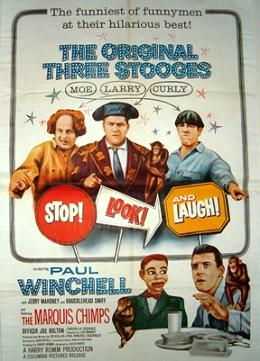 In 1958, Columbia Pictures dusted off their short films starring The Three Stooges and unceremoniously dumped them on television stations across the country, hoping for nothing more than a quick buck from an outdated format. Local stations were eager for product in those days to fill the early morning and afternoon hours when children would be their primary viewers and what self respecting child didn’t love The Three Stooges? Most stations either incorporated the shorts into their existing kiddie show programs or created new ones specifically for them. This was a time when almost anything shown on television was thought to require some original content so studio employees were often tapped to create colorful characters to introduce cartoons, educational films, or whatever other material could be used to fill an hour or two of children’s entertainment.
In 1958, Columbia Pictures dusted off their short films starring The Three Stooges and unceremoniously dumped them on television stations across the country, hoping for nothing more than a quick buck from an outdated format. Local stations were eager for product in those days to fill the early morning and afternoon hours when children would be their primary viewers and what self respecting child didn’t love The Three Stooges? Most stations either incorporated the shorts into their existing kiddie show programs or created new ones specifically for them. This was a time when almost anything shown on television was thought to require some original content so studio employees were often tapped to create colorful characters to introduce cartoons, educational films, or whatever other material could be used to fill an hour or two of children’s entertainment.
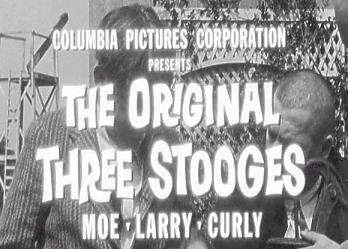
Just in case you forgot which Stooges you were watching.
Contrary to Columbia’s fast cash philosophy, The Three Stooges were a genuine hit with a brand new audience which was seeing most of their shorts for the first time. The ratings soared and soon just about every television market in the country was showing some variation of Stooges programming. Rather than being a dead end, Columbia found itself in need of even more product for the Stooge hungry public. Their initial reaction was to reform the group with Vaudeville comedian Joe DeRita replacing miscast Joe Besser in the third Stooge role. Since short subjects were all but dead in movie theaters and the Stooges were pushing for bigger opportunities, they embarked on a successful string of feature films starting in 1959 with Have Rocket, Will Travel.
Feature films, no matter how cheaply or quickly produced, still take time to make it in to theaters. Columbia was still not convinced that their newly revived cash cow would produce milk for long so their solution was a bizarre concoction of tenuously related material that they could pass off as a new product. Essentially the feature film equivalent of a Three Stooges kiddie television show, Stop, Look, and Laugh stars ventriloquist Paul Winchell in the host role where he is supported in various connecting sketches by his dummies Jerry Mahoney and Knucklehead Smiff. Toss in some Three Stooges antics and a bunch of talking chimpanzees and you get one hodge podge of a movie!
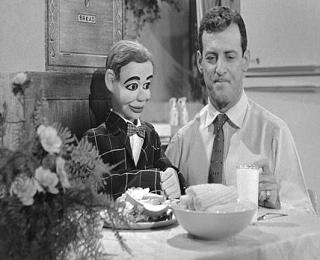
Paul Winchell and his irritating dummy Jerry Mahoney.
The framing device of the film is a typical day in the life of Mr. Winchell and his “son” Jerry Mahoney. They clearly define their relationship as a parent/child one which makes it extremely creepy that they sleep in the same bed! Jerry does everything he can to cause Paul grief, from refusing to get up in the morning, to faking illnesses to avoid school, and even setting booby-traps for his frantic father for when he isn’t home to harass him in person. I’ve always been a fan of ventriloquists but any way you look at it, Mahoney is one annoying hunk of wood. After hearing his supposed catch phrase of “don’t hollah” for the fifth or sixth time, it’s a wonder Winchell doesn’t break out the kerosene and turn Jerry into a bonfire. Winchell’s other dummy, the marginally less annoying and quasi-retarded Knucklehead Smiff plays a neighbor and friend in several sequences.
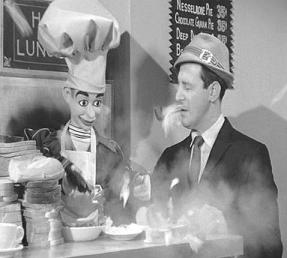
Knucklehead Smiff is the LAST person you want to see with a gun!
Paul and Jerry’s misadventures in daily routine serve as introductions to segue into scenes from eleven different Three Stooges shorts, some already over twenty years old by this time. This appropriated footage doesn’t match the rest of the film well in either content or quality. The dingy grain of the vintage film is a stark contrast to the crisp clarity of the newer scenes and, even devoid of context and heavily edited, The Three Stooges are still funny! The shorts selected for this movie all feature Curly and include some of the trio’s best work. The wrap around footage comes off as nothing more than a conduit to get viewers to the good stuff with the Stooges.
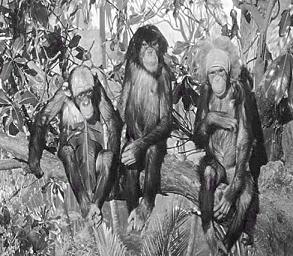
The Marquis Chimps in an early cameo as the Stooges ancestors.
Wisely realizing that Winchell and his entourage couldn’t carry the framing sequences on their own, Columbia tagged on even more disparate footage. Around the three-quarter mark in the film, Paul tells Knucklehead a bedtime story that turns into an extended sequence of the Marquis Chimps acting out the classic tale of Cinderella. While chimpanzees dressed as people are always amusing, the dubbed in voices are shrill and rapidly become nerve wracking. The final piece of stock footage is arguably the best known bit in Stooge-dom, the pie fight scene from Half-Wits Holiday. Pushing the surreal envelope just a bit farther, Winchell is inserted into the fight when he goes next door to complain about his noisy neighbors. Upon opening the door to the supposed house where the ruckus is taking place, he is hit squarely in the face with a pie and exclaims “this is the end” as the credits role. Amen Paul, amen.
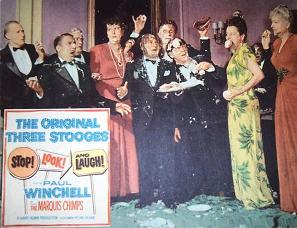 Needless to say, Stop, Look and Laugh is not held in high regard by Stooge fans. Even the Stooges themselves took offense to Columbia rehashing their shorts without their consent and legal action was threatened. Fortunately an agreement was reached, the Stooges continued to make films for the studio and Columbia never again tried to make a feature out of their shorts. This mosaic of mirth has softened a bit with age and now seems like an oddball one shot swept into the corner of classic comedy. This film probably remains the most recognizable piece on the resumes of both Paul Winchell and the Marquis Chimps. In a strange twist of fate, Winchell would go on to host his own children’s show, Winchell-Mahoney Time, a few years later and then find success doing voiceover work in cartoons, most notably as Tigger in the Winnie the Pooh films for Walt Disney. The chimps seem to have fallen into obscurity after this and likely went on to either television series like Lancelot Link or scientific research. While the Stooges were not properly represented in their portions of the film, their comedy genius still manages to shine through and this feature may have introduced them to a younger generation who hadn’t discovered them on television yet.
Needless to say, Stop, Look and Laugh is not held in high regard by Stooge fans. Even the Stooges themselves took offense to Columbia rehashing their shorts without their consent and legal action was threatened. Fortunately an agreement was reached, the Stooges continued to make films for the studio and Columbia never again tried to make a feature out of their shorts. This mosaic of mirth has softened a bit with age and now seems like an oddball one shot swept into the corner of classic comedy. This film probably remains the most recognizable piece on the resumes of both Paul Winchell and the Marquis Chimps. In a strange twist of fate, Winchell would go on to host his own children’s show, Winchell-Mahoney Time, a few years later and then find success doing voiceover work in cartoons, most notably as Tigger in the Winnie the Pooh films for Walt Disney. The chimps seem to have fallen into obscurity after this and likely went on to either television series like Lancelot Link or scientific research. While the Stooges were not properly represented in their portions of the film, their comedy genius still manages to shine through and this feature may have introduced them to a younger generation who hadn’t discovered them on television yet.
